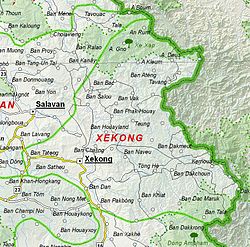Sekong Province
|
Sekong ເຊກອງ |
|
|---|---|
| Province | |
 |
|
 Map of Sekong Province |
|
 Location of Sekong Province in Laos |
|
| Coordinates: 15°43′00″N 106°39′00″E / 15.7166°N 106.65°ECoordinates: 15°43′00″N 106°39′00″E / 15.7166°N 106.65°E | |
| Country |
|
| Capital | Sekong |
| Area | |
| • Total | 7,665 km2 (2,959 sq mi) |
| Population (2015 census) | |
| • Total | 113,048 |
| • Density | 15/km2 (38/sq mi) |
| Time zone | UTC+07 |
| ISO 3166 code | LA-XE |
Sekong (also sometimes Xekong, Lao ເຊກອງ) is a province of Laos, located in the south-east of the country.
Sekong Province is the second smallest province in Laos and also one of its poorest, covering an area of 7,665 square kilometres (2,959 sq mi). It is bordered by Vietnam to the east, Attapeu Province to the south, Salavan Province to the north, and Champasak Province to the west. Sekong also has the smallest population (113,048 as of 2015) and the lowest population density of any province. It was created in 1984 by splitting the Salavan Province and is the most diverse province in Laos with 14 ethnic groups. The Sekong River, which divides the province, flows in a southern direction into Cambodia and is navigable for boats. The river valley has fertile plains interspersed with paddy fields and fruit orchards. Its rich tropical forest have many rare species of flora and fauna. The Dakchung Plateau and Xe Xap National Biodiversity Conservation Area are among the areas under protection.
Unlike most of Laos, not many wats are seen in the province as the predominant belief system is more of animism and ancestral worship. Sekong Province is one of the most important coffee producing areas of Laos.
Sekong was created in 1984, when it was split off from Salavan Province. and Attapeu Province. After it became a separate province, it has become ethnically a most diverse province in Laos with 14 ethnic groups reported from a population of 85,000. Since these groups are not Buddhist not many wats are seen in the province as their belief system is more of animism and ancestral worship. During the communist regime, the province was created to give benefits to the local ethnic groups. However, this advantage seems to be on the decline with ethnic Lao groups dominating the political scene and also in the local administration.
Sekong Province, one of the provinces in Laos, is the second smallest province, covering an area of 7,665 square kilometres (2,959 sq mi). It is bordered by Vietnam to the east, Attapeu Province to the south, Salavan Province to the north, and Champasak Province to the west. Sekong also has the lowest population (about 83,000) and the lowest population density of any province. Sekong is split administratively into four districts: Thateng on the Bolaven Plateau, Lamam in the lowland plain, and Dakchung and Kaleum in the mountainous areas bordering Vietnam. The Tad Xe Noi waterfall is located 25 kilometres (16 mi) south of Sekong city.
...
Wikipedia
